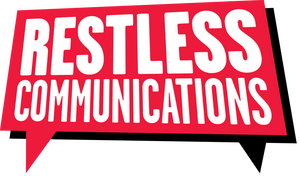We live in an industry where it’s all too easy to criticise our peers. We’ve all got blogs, tweet away to our heart’s content and are opinionated. Normally I refrain, but today I thought I’d get a few thoughts down about how Vodafone handled crisis communications around this morning’s service outage.
I’m on the crisis panel for forthcoming Social Media Influence conference (partly because of my work with Eurostar in January last year helping to deliver a joined up communications strategy across their social media and corporate comms teams they emerged from their snow-induced crisis).
So, as part of my homework for that I set Tweetdeck running for #vodafone, and kept a beedy eye on how Vodafone UK were responding to customers and national journalists tweeting about them, on Facebook, their own site, and on their customer forum.
And I’m sorry to say, from my perspective (I’m not a customer, I wasn’t affected), they didn’t cover themselves in glory. However, I suspect the reasons why this was so were almost all to do with the speed of internal decision-making and sign-off.
Not because the social media or PR team weren’t doing a fine job.
I suspect they were.
Just that they really don’t appear to have been given a lot of information to go on.
They weren’t given it early. And they were extremely restricted in what they could say.
First, the facts.
As reported on their owned media, and then by the BBC and elsewhere, there was a break-in and theft of kit in Basingstoke, (as always – never in the crisis plans) which knocked-out a signifcant amount of signal.
Vodafone posted something on their owned media 9 hours after the event, after they’d started trending on Twitter, at 9.44am.But not anywhere particularly obvious.
I’m guessing, that like a lot of corporate sites, most of the site is locked down under a very restrictive CMS and approval process. So the statement went in the most dynamic place possible, within the latest news section.
It was highlighted from Facebook and Twitter (totally the right thing to do), as part of their ‘news hub’ and the national media picked up the story
Customers were starting to get angry, and “take to the tweets” to complain.
Rory Cellan-Jones, amongst others, no doubt, was waiting for more information.
But still, Vodafone didn’t say anything more than was on the original statement. To anyone.
Except they did comment on Facebook, referring people back to that original statement. Nothing more.
Nothing less. A very oldschool PR approach.
Also on Facebook, while some customers got extremely angry with Vodafone’s response being apparently buried in a forum people couldn’t comment on, others jumped in to their defence: the troll in their midst became a focal point, not the original issue. Trolls have their uses…
But by now a Vodafone employee with access to internal information took the liberty of posting the initial incident report (from 12.48am) to an external forum. Which provided a bit more information to people to go on, but didn’t set the world on fire. Though it does show the need to dovetail internal and external comms.
And meanwhile Tom Peck (who writes for the Independent) also failed to find new information…and one cheeky chappie managed to find a link with the UK Uncut movement.
But at 12.48 – three hours after the first post went up on the “latest vodafone news – network issues forum”, and 12 hours after the incident which caused the whole issue was first reported internally, more information was forthcoming.
Not a lot of new information, and not an apology in sight. But it was more information. And, by this stage the operational issues appeared to be pretty well-managed and were clearly improving.
A new Facebook post went up, saying we’ve updated our response. The Twitter team dutifully @replied everyone who’d asked them what was happening, and things appeared to be calming down…
Twitter volumes were heading back to normal, and it was back to business as usual.
So what could they have done differently?
I don’t know all the facts, but having seen a number of customers threaten to leave Vodafone on their Facebook page, it strikes me that there were three major things that, if done differently might have improved the situation, and I suspect one major structural thing.
- Unless there are really good long-term reasons for trying to drive people to their own Forum (on which they can’t comment), I can’t understand why more information wasn’t published on Facebook, more often. To have only two updates which dealt with the issue, punctuated by a marketing-update in between (which struck me as insensitive to say the least, even though only people in the South East were affected by the outage) over 12 hours since the incident was reported seems thin
- The tone of voice could have been softened. The response read to me like press-office originated lines against enquiry, initially drafted for journalists, and then cut and pasted onto the forum. Nowadays, I’d say those LAEs should be re-written in 140 chars if poss, and be much more customer-focused
- But the biggest thing – bigger than the frequency of the updates, the location of those updates, and the tone of them, was that there was no apology. I know we live in litigious times, and I suspect the reason there was no apology was due to legal worries, but it just doesn’t read well. It really doesn’t. But I’m bound to say that aren’t I? I’m a comms guy, not a lawyer.
As for the structural issue: I’d say it’s pretty fundamental, and that it looks like different teams within Vodafone UK currently own different channels of communication – the forum, customer service channels, The Press Office, Facebook (for marketing), Facebook (for reputation-defending) and Twitter – and while that’s the case, joining them all up to use consistent, approved lines against enquiry will inevitably be political, and time-consuming. 10p says that’s what happened this time.
I’ve been impressed with Vodafone previously (in particular how they dealt with last year’s rogue tweet), and given that they’ve been in the firing line a lot recently (what with the makesmeesmile own-goal, and the unwanted UK Uncut attention), I hoped to monitor today’s events to see a case study in best-practice crisis comms in action. But it didn’t. Maybe next time…
Having said all that, if you think I’ve got the wrong end of the stick, or you’re from Vodafone and I need to be corrected on something, let me know. I’m all ears.


